|
ARMORED TRAIN. (SANTA CLARA)
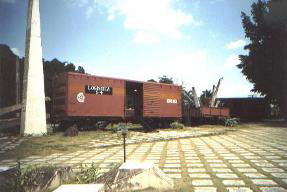 Located in the city of Santa Clara, it is quite a unique attraction for those lovers of Cuba’s history. There, on November 29th of 1958, troops from Column 8 led by Ernesto Che Guevara, struck a hard blow to Batista’s tyranny by derailing an armoured train, carrying reinforcement soldiers to fight the Rebel Army (Ejército Rebelde) in the eastern area of the island.
This monument was raised 13 years after the audacious attack took place, and years later on July 13th of 1986 it adopted a new artistic format, created by the Cuban sculptor José Delarra. The complex is made up of five sculptured elements that represent the actions that were carried out, as well as four original wagons, the bulldozer used to rip out the railway and a steamroller. Inside the wagons there are photographs of the events, as well as weapons similar to those taken from the enemy. It was declared a National Monument in 1990.
Located in the city of Santa Clara, it is quite a unique attraction for those lovers of Cuba’s history. There, on November 29th of 1958, troops from Column 8 led by Ernesto Che Guevara, struck a hard blow to Batista’s tyranny by derailing an armoured train, carrying reinforcement soldiers to fight the Rebel Army (Ejército Rebelde) in the eastern area of the island.
This monument was raised 13 years after the audacious attack took place, and years later on July 13th of 1986 it adopted a new artistic format, created by the Cuban sculptor José Delarra. The complex is made up of five sculptured elements that represent the actions that were carried out, as well as four original wagons, the bulldozer used to rip out the railway and a steamroller. Inside the wagons there are photographs of the events, as well as weapons similar to those taken from the enemy. It was declared a National Monument in 1990.
For more information:
www.cuba-heroes.com
,
www.cuba-history.com
,
www.cuba-villaclara.com
|
|
|
Birth House of Abel Santamaría Cuadrado
Museum
2da. del Norte No. 1, Encrucijada
It was declared a National Monument by Resolution 29, dictated in Havana City on December 31st of 1981.
The house was built in the twenties of wood and tiles. The inner floor is of mosaics, while the outer flooring is of cement. It is of vernacular construction. Here, Abel Santamaría Cuadrado was born in the year of 1927, and he also spent most of his childhood in this house.
The museum has seven permanent exhibit rooms, one temporary exhibition and another room for activities.
At the moment there are five rooms already functioning and two are being set up.
The museum is considered a polyvalent museum since it exhibits great historical moments of the municipality of Encrucijada.
Address: 2da del Norte # 1
e/ Central y 1ra del Este
Encrucijada, Villa Clara, Cuba
For more information:
www.cuba-heroes.com
,
www.cuba-history.com
,
www.cuba-museums.com
,
www.cuba-villaclara.com
|
|
|
CABALLETE DE CASA
Caballete de Casa, among the Escambray mountains, in the centre of the island, was the site chosen by the Comandante Guerrillero (Ernesto Che Guevara) for establishing his headquarters.
Ernesto Che Guevara’s Headquarters (Comandancia de Ernesto Che Guevara) during the struggle before 1959, located in Caballete de Casa, in the mountain massif of the Escambray, in the centre of the country, is currently being restored.
According to the National Agency of Information (Agencia de Información Nacional), the work being carried out reproduces exactly the legendary facilities used by the heroic warrior of Argentine-Cuban descent, as a training school for the Number Eight Column of the Rebel Army (Ejercito Rebelde), before 1959.
The ensemble, declared a National Monument 20 years ago, has a structure of rustic wooden props, covered by palm leaves.
Caballete de Casa, some 440 kilometres southeast of Havana, is the highest elevation of Fomento’s geography, in the province of Sancti Spíritus, 764 metres above sea level.
For more information:
www.cuba-che.com
,
www.cuba-escambray.com
,
www.cuba-heroes.com
,
www.cuba-history.com
,
www.cuba-sanctispiritus.com
|
|
|
IGLESIA DEL CARMEN (CHURCH OF CARMEN) AND SURROUNDING AREA
Declared a National Monument on December 11th of 1991. Located in the Plaza del Carmen along the Máximo Gómez street between San Pablo and Conyedo. The founding of the city took place on July 15th of 1689, right next to this site.
Close to Arroyo de la Sabana, today called river Belico (río Bélico), the priest Fray Salvador Guillén offered the first mass. Years later, in the place where the Temple of Carmen (Ermita del Carmen) had stood, a tamarind tree was planted and in 1951 a monument was built in honour of this first mass.
There are several plaques in the park that honour important events, as well as busts and monuments, among them, the one dedicated to Captain Roberto Rodríguez, El Vaquerito.
For more information:
www.cuba-history.com
,
www.cuba-religion.com
,
www.cuba-villaclara.com
|
|
|
La Caridad Theater. Santa Clara
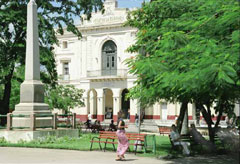 A unique architectural building located in the heart of the city of Santa Clara (276 kilometres east of Havana) which opened on September 8th of 1885 and was declared a National Monument of Cuba in 1981. The building was constructed thanks to the generosity of Marta Abreu de Estévez, a member of an illustrious and wealthy family of the area, who financed it’s building and later on donated it to the city so that part of its income would be destined to the poor.
For years famous actors and actresses have performed on its stage, such as Enrico Caruso, Libertad Lamarque, Jorge Negrete, Rosita Fornés, Lola Flores, Chucho Valdés, Alicia Alonso and the Cuban National Ballet. Today it is still open to the public as a theatre that offers the visitor the possibility of being transported back in time.
A unique architectural building located in the heart of the city of Santa Clara (276 kilometres east of Havana) which opened on September 8th of 1885 and was declared a National Monument of Cuba in 1981. The building was constructed thanks to the generosity of Marta Abreu de Estévez, a member of an illustrious and wealthy family of the area, who financed it’s building and later on donated it to the city so that part of its income would be destined to the poor.
For years famous actors and actresses have performed on its stage, such as Enrico Caruso, Libertad Lamarque, Jorge Negrete, Rosita Fornés, Lola Flores, Chucho Valdés, Alicia Alonso and the Cuban National Ballet. Today it is still open to the public as a theatre that offers the visitor the possibility of being transported back in time.
For more information:
www.cuba-coins.com
,
www.cuba-history.com
,
www.cuba-villaclara.com
|
|
|
LEONCIO VIDAL PARK. (SANTA CLARA)
Its history dates back to the founding of the Villa, when a square of 1 600 metres was marked out in order to build the Plaza de Armas. In the area of the present day park, bull fights, equitation competitions, plays and all kinds of games, such as cards and dice, are held.
Every 15th of July, on the anniversary of the Villa’s founding, the people of Santa Clara celebrate with huge parties in this place, where there were four pine trees and almond trees marking the four cardinal points. From being the Plaza de Armas, it later became the Plaza Mayor and afterwards, Plaza Constitucional, until it was remodelled in 187l by order of the Chapter House and renamed Recreation Plaza (Plaza de Recreo). Its current name, dates back to the XIX century in honour of the deceased independent Colonel Leoncio Vidal.
For more information:
www.cuba-villaclara.com
|
|
|
PASO DE LAS DAMAS, TAGUASCO
Paso de las Damas, another place in this historic municipality, is where Major General Serafín Sánchez Valdivia fell in mortal combat. He was a hero of the three wars of Independence.
Serafín Sánchez Valdivia was born in Sancti Spíritus, in 1846. He joined the insurrectional movement in Las Villas from the beginning. He fought bravely during the War of Ten Years (Guerra de los Diez Años) and also was among those who organised the Small War (Guerra Chiquita) movement in 1879. He was a good friend of José Martí and carried out formidable revolutionary propaganda in Key Hueso.
In the War of 95 (Guerra del 95) he planned and fought successful battles, winning the admiration of Gómez and Maceo. On November 18th of 1896, at Paso de las Damas, during a rough encounter with the Spanish troops, superior in number to the Cubans, General Serafín Sánchez was mortally wounded. Still astride, he exclaimed “They have killed me. That is nothing. Continue the march.”
For more information:
www.cuba-heroes.com
,
www.cuba-history.com
,
www.cuba-villaclara.com
|
|
|
REMAINS OF THE TRAIL (TROCHA) FROM JÚCARO TO MORÓN
A brief history of the Trail (Trocha) from Júcaro to Morón.
In the wars of 1868 and 1895, the Trocha was an insurmountable barrier, as the Spanish thought, and after it was finished, it became the most perfect and sophisticated military construction that the Spanish Colonialism had in America. Of course it was never a deterrent for the glorious Mambi Army (Ejército Mambí), who in both wars kept crossing it ,showing the ingenious strategies deployed by their military chiefs, among them Máximo Gómez and Antonio Maceo, with the help of other insurrectional chiefs of the area, such as Brigadier José Gómez Cardoso and Colonel Simón Reyes Hernández, known as the Eagle of the Trocha (El Águila de la Trocha).
The aim of this military line was to isolate the mambi forces in the eastern area, in order to deter help and break contact between the insurrectional forces in the central and eastern regions, and to stop the invaders, led by Máximo Gómez and Antonio Maceo from extending the war to the western region of the country, an event that would wear down the strength of Spanish colonialism, leading up to its final fall.
By the end of March of 1871, three years from the Cry of Yara (Grito de Yara), General Blas Villate de la Hera, Count of Valmaseda, proposed to the Overseas Minister of the Spanish Crown; the construction of a trocha or fortified line, from the port of Júcaro, on the southern coast; running across the island, to the settlement of Morón, on the northern coast.
Valmaseda’s proposal was approved, and construction on the trocha was started. It started out with 17 fortresses and in 1874, 16 bunkers had been added on, more than five thousand men were employed to guard it, these soldiers had modern infantry weapons as well as ten pieces of artillery, which were moved along the Trocha by a narrow railway, which also allowed them to quickly move the troops from one end to the other.
For more information:
www.cuba-heroes.com
,
www.cuba-history.com
,
www.cuba-matanzas.com
,
www.cuba-cienfuegos.com
,
www.cuba-villaclara.com
,
www.cuba-sanctispiritus.com
|
|
|
REMEDIOS
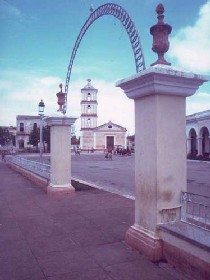 San Juan de los Remedios was the eighth villa founded by the Spanish in 1515. The historical centre was declared a National Monument in 1980 and has a unique plaza, since it is the only one in the country where two churches stand: Our Lady of the Good Trip (Nuestra Señora del Buen Viaje) and the Parroquia Mayor, in the latter there is a huge altar gilded in gold leaf and a sculpture representing the pregnant Immaculate Conception, which is said to be unique in the whole world.
Another main attraction is the so-called “Parrandas de Remedios”, which are fun festivities originating on the eve of every December 24th and always extending until Christmas morning.
Another featured attraction for those who enjoy health tourism is the Elguea Spa (Balneario de Elguea), rich in medicinal waters. The centre is gifted with modern equipment, and among the multiple options to choose from there are anti-stress treatments.
San Juan de los Remedios was the eighth villa founded by the Spanish in 1515. The historical centre was declared a National Monument in 1980 and has a unique plaza, since it is the only one in the country where two churches stand: Our Lady of the Good Trip (Nuestra Señora del Buen Viaje) and the Parroquia Mayor, in the latter there is a huge altar gilded in gold leaf and a sculpture representing the pregnant Immaculate Conception, which is said to be unique in the whole world.
Another main attraction is the so-called “Parrandas de Remedios”, which are fun festivities originating on the eve of every December 24th and always extending until Christmas morning.
Another featured attraction for those who enjoy health tourism is the Elguea Spa (Balneario de Elguea), rich in medicinal waters. The centre is gifted with modern equipment, and among the multiple options to choose from there are anti-stress treatments.
For more information:
www.cuba-cayosantamaria.com
,
www.cuba-elguea.com
,
www.cuba-villaclara.com
,
www.cuba-cayolasbrujas.com
|
|
|
SANCTI SPIRITUS
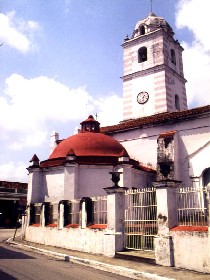 Sancti Spiritus is a province where there are many tourist attractions, among them the Villa of the Holy Trinity (Villa de la Santísima Trinidad), some 67 kilometres from the Villa del Espíritu Santo, capital of the province of Sancti Spíritus.
It was founded in 1514 and is among the first seven cities established by the Spanish on the island.
Among the places to visit are the Church (Iglesia Mayor), Main Theatre (Teatro Principal) and the Bridge over the Yayabo river (Puente sobre el Río Yayabo).
This last was intended for the crossing over of carriages and wheelbarrows and in the present still conserves its ancient slenderness. Many people catalogue it as an open-air museum.
The baroque Spanish style can be appreciated in a good part of its mansions and in the classical design of the Church (Iglesia Mayor), together with its plaza, which evolved into constructions more adapted to the country’s climate.
Sancti Spiritus is a province where there are many tourist attractions, among them the Villa of the Holy Trinity (Villa de la Santísima Trinidad), some 67 kilometres from the Villa del Espíritu Santo, capital of the province of Sancti Spíritus.
It was founded in 1514 and is among the first seven cities established by the Spanish on the island.
Among the places to visit are the Church (Iglesia Mayor), Main Theatre (Teatro Principal) and the Bridge over the Yayabo river (Puente sobre el Río Yayabo).
This last was intended for the crossing over of carriages and wheelbarrows and in the present still conserves its ancient slenderness. Many people catalogue it as an open-air museum.
The baroque Spanish style can be appreciated in a good part of its mansions and in the classical design of the Church (Iglesia Mayor), together with its plaza, which evolved into constructions more adapted to the country’s climate.
For more information:
www.cuba-escambray.com
,
www.cuba-trinidad.com
,
www.cuba-sanctispiritus.com
|
|
|
SANTA CLARA
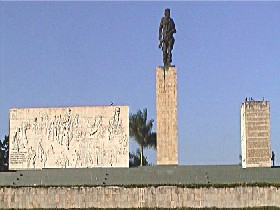 Capital of the province of Villa Clara, its founding dates back to 1689. It is some 270 kilometres east of Havana. It is a typical city and many of its inhabitants live in brick houses with red clay roof tiles, in a quaint reminder of small Spanish villages.
Many identify it as the city of Che, due to the fact that in this city the Heroic Warrior fought at the head of his invading column for Cuba’s freedom, one of the last struggles for independence in December of 1958.
Millions of people have visited the Memorial Ernesto Che Guevara, located at the doors of Santa Clara and raised in honour of Che and the rest of the warriors that fought by his side in Bolivia.
In this esplanade many political acts and graduations have been celebrated, among other activities. It was also the scene of a giant chess competition on April 29th of 2004, with the presence of over 13 000 players.
Capital of the province of Villa Clara, its founding dates back to 1689. It is some 270 kilometres east of Havana. It is a typical city and many of its inhabitants live in brick houses with red clay roof tiles, in a quaint reminder of small Spanish villages.
Many identify it as the city of Che, due to the fact that in this city the Heroic Warrior fought at the head of his invading column for Cuba’s freedom, one of the last struggles for independence in December of 1958.
Millions of people have visited the Memorial Ernesto Che Guevara, located at the doors of Santa Clara and raised in honour of Che and the rest of the warriors that fought by his side in Bolivia.
In this esplanade many political acts and graduations have been celebrated, among other activities. It was also the scene of a giant chess competition on April 29th of 2004, with the presence of over 13 000 players.
For more information:
www.cuba-cayosantamaria.com
,
www.cuba-elguea.com
,
www.cuba-villaclara.com
,
www.cuba-cayolasbrujas.com
|
|
|
TRINIDAD
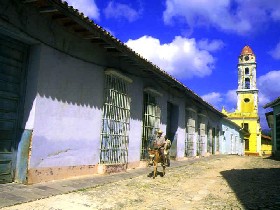 The Villa of Trinidad, the third founded in the country, was originally located along the shores of the Tuinucú River, and later moved to the shores of the Yayabo River in 1552. It features many cultural and architectural values, as well as beautiful landscapes that form harmonic scenery enjoyed by many visitors.
Declared a Heritage of Humanity by UNESCO in December of 1998 it invites one to tour its stoned streets and discover each historical event of the villa, jealously preserved by its dwellers.
The sugar industry and its splendour also tell the story of the Villa’s history, with the San Luis Valley or Sugar Mill Valley (Valle de San Luis o Valle de los Ingenios), that is now an important archaeological reserve.
The Villa of Trinidad, the third founded in the country, was originally located along the shores of the Tuinucú River, and later moved to the shores of the Yayabo River in 1552. It features many cultural and architectural values, as well as beautiful landscapes that form harmonic scenery enjoyed by many visitors.
Declared a Heritage of Humanity by UNESCO in December of 1998 it invites one to tour its stoned streets and discover each historical event of the villa, jealously preserved by its dwellers.
The sugar industry and its splendour also tell the story of the Villa’s history, with the San Luis Valley or Sugar Mill Valley (Valle de San Luis o Valle de los Ingenios), that is now an important archaeological reserve.
For more information:
www.cuba-escambray.com
,
www.cuba-trinidad.com
,
www.cuba-sanctispiritus.com
|
|
 Located in the city of Santa Clara, it is quite a unique attraction for those lovers of Cuba’s history. There, on November 29th of 1958, troops from Column 8 led by Ernesto Che Guevara, struck a hard blow to Batista’s tyranny by derailing an armoured train, carrying reinforcement soldiers to fight the Rebel Army (Ejército Rebelde) in the eastern area of the island.
This monument was raised 13 years after the audacious attack took place, and years later on July 13th of 1986 it adopted a new artistic format, created by the Cuban sculptor José Delarra. The complex is made up of five sculptured elements that represent the actions that were carried out, as well as four original wagons, the bulldozer used to rip out the railway and a steamroller. Inside the wagons there are photographs of the events, as well as weapons similar to those taken from the enemy. It was declared a National Monument in 1990.
Located in the city of Santa Clara, it is quite a unique attraction for those lovers of Cuba’s history. There, on November 29th of 1958, troops from Column 8 led by Ernesto Che Guevara, struck a hard blow to Batista’s tyranny by derailing an armoured train, carrying reinforcement soldiers to fight the Rebel Army (Ejército Rebelde) in the eastern area of the island.
This monument was raised 13 years after the audacious attack took place, and years later on July 13th of 1986 it adopted a new artistic format, created by the Cuban sculptor José Delarra. The complex is made up of five sculptured elements that represent the actions that were carried out, as well as four original wagons, the bulldozer used to rip out the railway and a steamroller. Inside the wagons there are photographs of the events, as well as weapons similar to those taken from the enemy. It was declared a National Monument in 1990.
 A unique architectural building located in the heart of the city of Santa Clara (276 kilometres east of Havana) which opened on September 8th of 1885 and was declared a National Monument of Cuba in 1981. The building was constructed thanks to the generosity of Marta Abreu de Estévez, a member of an illustrious and wealthy family of the area, who financed it’s building and later on donated it to the city so that part of its income would be destined to the poor.
For years famous actors and actresses have performed on its stage, such as Enrico Caruso, Libertad Lamarque, Jorge Negrete, Rosita Fornés, Lola Flores, Chucho Valdés, Alicia Alonso and the Cuban National Ballet. Today it is still open to the public as a theatre that offers the visitor the possibility of being transported back in time.
A unique architectural building located in the heart of the city of Santa Clara (276 kilometres east of Havana) which opened on September 8th of 1885 and was declared a National Monument of Cuba in 1981. The building was constructed thanks to the generosity of Marta Abreu de Estévez, a member of an illustrious and wealthy family of the area, who financed it’s building and later on donated it to the city so that part of its income would be destined to the poor.
For years famous actors and actresses have performed on its stage, such as Enrico Caruso, Libertad Lamarque, Jorge Negrete, Rosita Fornés, Lola Flores, Chucho Valdés, Alicia Alonso and the Cuban National Ballet. Today it is still open to the public as a theatre that offers the visitor the possibility of being transported back in time.
 San Juan de los Remedios was the eighth villa founded by the Spanish in 1515. The historical centre was declared a National Monument in 1980 and has a unique plaza, since it is the only one in the country where two churches stand: Our Lady of the Good Trip (Nuestra Señora del Buen Viaje) and the Parroquia Mayor, in the latter there is a huge altar gilded in gold leaf and a sculpture representing the pregnant Immaculate Conception, which is said to be unique in the whole world.
Another main attraction is the so-called “Parrandas de Remedios”, which are fun festivities originating on the eve of every December 24th and always extending until Christmas morning.
Another featured attraction for those who enjoy health tourism is the Elguea Spa (Balneario de Elguea), rich in medicinal waters. The centre is gifted with modern equipment, and among the multiple options to choose from there are anti-stress treatments.
San Juan de los Remedios was the eighth villa founded by the Spanish in 1515. The historical centre was declared a National Monument in 1980 and has a unique plaza, since it is the only one in the country where two churches stand: Our Lady of the Good Trip (Nuestra Señora del Buen Viaje) and the Parroquia Mayor, in the latter there is a huge altar gilded in gold leaf and a sculpture representing the pregnant Immaculate Conception, which is said to be unique in the whole world.
Another main attraction is the so-called “Parrandas de Remedios”, which are fun festivities originating on the eve of every December 24th and always extending until Christmas morning.
Another featured attraction for those who enjoy health tourism is the Elguea Spa (Balneario de Elguea), rich in medicinal waters. The centre is gifted with modern equipment, and among the multiple options to choose from there are anti-stress treatments.
 Sancti Spiritus is a province where there are many tourist attractions, among them the Villa of the Holy Trinity (Villa de la Santísima Trinidad), some 67 kilometres from the Villa del Espíritu Santo, capital of the province of Sancti Spíritus.
It was founded in 1514 and is among the first seven cities established by the Spanish on the island.
Among the places to visit are the Church (Iglesia Mayor), Main Theatre (Teatro Principal) and the Bridge over the Yayabo river (Puente sobre el Río Yayabo).
This last was intended for the crossing over of carriages and wheelbarrows and in the present still conserves its ancient slenderness. Many people catalogue it as an open-air museum.
The baroque Spanish style can be appreciated in a good part of its mansions and in the classical design of the Church (Iglesia Mayor), together with its plaza, which evolved into constructions more adapted to the country’s climate.
Sancti Spiritus is a province where there are many tourist attractions, among them the Villa of the Holy Trinity (Villa de la Santísima Trinidad), some 67 kilometres from the Villa del Espíritu Santo, capital of the province of Sancti Spíritus.
It was founded in 1514 and is among the first seven cities established by the Spanish on the island.
Among the places to visit are the Church (Iglesia Mayor), Main Theatre (Teatro Principal) and the Bridge over the Yayabo river (Puente sobre el Río Yayabo).
This last was intended for the crossing over of carriages and wheelbarrows and in the present still conserves its ancient slenderness. Many people catalogue it as an open-air museum.
The baroque Spanish style can be appreciated in a good part of its mansions and in the classical design of the Church (Iglesia Mayor), together with its plaza, which evolved into constructions more adapted to the country’s climate.
 Capital of the province of Villa Clara, its founding dates back to 1689. It is some 270 kilometres east of Havana. It is a typical city and many of its inhabitants live in brick houses with red clay roof tiles, in a quaint reminder of small Spanish villages.
Many identify it as the city of Che, due to the fact that in this city the Heroic Warrior fought at the head of his invading column for Cuba’s freedom, one of the last struggles for independence in December of 1958.
Millions of people have visited the Memorial Ernesto Che Guevara, located at the doors of Santa Clara and raised in honour of Che and the rest of the warriors that fought by his side in Bolivia.
In this esplanade many political acts and graduations have been celebrated, among other activities. It was also the scene of a giant chess competition on April 29th of 2004, with the presence of over 13 000 players.
Capital of the province of Villa Clara, its founding dates back to 1689. It is some 270 kilometres east of Havana. It is a typical city and many of its inhabitants live in brick houses with red clay roof tiles, in a quaint reminder of small Spanish villages.
Many identify it as the city of Che, due to the fact that in this city the Heroic Warrior fought at the head of his invading column for Cuba’s freedom, one of the last struggles for independence in December of 1958.
Millions of people have visited the Memorial Ernesto Che Guevara, located at the doors of Santa Clara and raised in honour of Che and the rest of the warriors that fought by his side in Bolivia.
In this esplanade many political acts and graduations have been celebrated, among other activities. It was also the scene of a giant chess competition on April 29th of 2004, with the presence of over 13 000 players.
 The Villa of Trinidad, the third founded in the country, was originally located along the shores of the Tuinucú River, and later moved to the shores of the Yayabo River in 1552. It features many cultural and architectural values, as well as beautiful landscapes that form harmonic scenery enjoyed by many visitors.
Declared a Heritage of Humanity by UNESCO in December of 1998 it invites one to tour its stoned streets and discover each historical event of the villa, jealously preserved by its dwellers.
The sugar industry and its splendour also tell the story of the Villa’s history, with the San Luis Valley or Sugar Mill Valley (Valle de San Luis o Valle de los Ingenios), that is now an important archaeological reserve.
The Villa of Trinidad, the third founded in the country, was originally located along the shores of the Tuinucú River, and later moved to the shores of the Yayabo River in 1552. It features many cultural and architectural values, as well as beautiful landscapes that form harmonic scenery enjoyed by many visitors.
Declared a Heritage of Humanity by UNESCO in December of 1998 it invites one to tour its stoned streets and discover each historical event of the villa, jealously preserved by its dwellers.
The sugar industry and its splendour also tell the story of the Villa’s history, with the San Luis Valley or Sugar Mill Valley (Valle de San Luis o Valle de los Ingenios), that is now an important archaeological reserve.